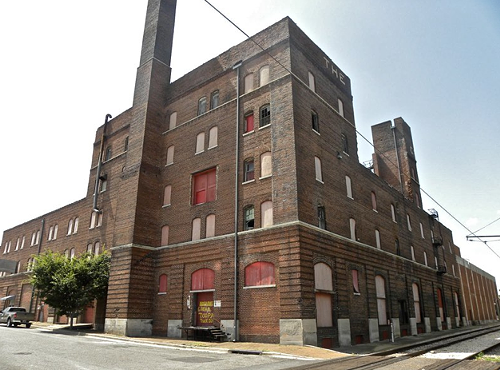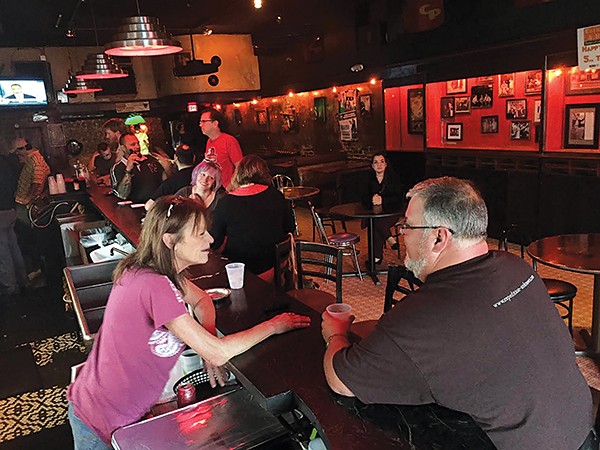Coming from a small town in Arkansas, Memphis was a dream for me. When I looked for my first apartment, I was guided to Midtown, where it was deemed imperative that I get a place with hardwood floors, high ceilings, crown molding, and hopefully a balcony. Places like this didn’t exist in my hometown.
When I moved to Los Angeles, my housing search was disappointing. The few apartments with historic character were very expensive, so I moved into a soulless box.
 Memphis Flyer
Memphis Flyer
Nylon Net Building
Knowing I would eventually return to Memphis and longing for the character of the places I used to live in, I purchased a Crosstown duplex with 12-foot-high sliding parlor doors. I soon learned that historic preservation and restoration isn’t the easiest path. It’s a unique skillset, and those only experienced with new construction fear the unknowns. You rarely hear someone who does adaptive reuse say that a building is too far gone. They ask for incentives to help save rather than permission to destroy.
There are always unexpected factors with historic buildings, but tax credits and other incentives can help make these projects feasible. When you buy a site with a historic building, the building cannot be in the way of your development — it is your development. From a cost perspective, developers say “it doesn’t pencil”, which often means “it doesn’t make as much profit as new construction.” But a project whose sole goal is profit has never resulted in greatness.
I own a guesthouse in a historic building downtown. Visitors often arrive with a list of what they want to see: Peabody, Beale Street, the Civil Rights Museum, the Orpheum, Sun Studios. Now they add the Crosstown Concourse. For food downtown, we recommend places from the Arcade on the South end to Alcenia’s at the North, with the Majestic as a favorite in between. Where to have a drink? Earnestine and Hazel’s is a must! Our guests return excited by the history they experience. Can you imagine the vibe of Earnestine and Hazel’s being recreated in new construction? Visitors come to experience food and entertainment that reflect our culture. They seek out the authentic places.
Frank Gehry said, “In the end, the character of a civilization is encased in its structures.” Imagine Paris or Rome without their historic buildings. The traditions and culture might remain, but the experience wouldn’t be the same. I was surprised by how many of my guests just wanted to drive around Central Gardens and Cooper Young, but then I realized neighborhoods are unique to each city, a prime reflection of who we are. Visitors want to feel the history.
Buildings house our memories. We drive by our childhood home, even though our family and neighbors might be long gone, because there’s a comfort in continuity. This is especially important in Memphis with its rich culture, history and musical heritage. With so many icons gone, what provides continuity with the past if not the physical? Preserving our architectural stateliness is to recognize inherent value in the uniqueness of our city. It makes us a part of something bigger than ourselves. Memphis’ soul comes from grit and strife. We should wear our scars with pride.
I am a historic preservationist, but I do not believe that every building should be saved. I have a great appreciation for modern architecture and quality new construction. Preservation and economic gain do not have to be at odds. They can work together to create progress, Artists find the good, and often historic, building stock, and the developers follow. The success of these “arts districts” and “historic districts” were built on the backs of the residents and small business owners who gave their all towards reviving these streets. Once the groundwork is laid, the “authenticity” lauded, and property values increasing, developers want in on the action. This isn’t necessarily a bad thing, but the approach is key. Memphis has plenty of empty lots, but limited historic building stock. So why do we talk about demolition?
An architect or developer who considers the architectural and cultural context of an area can be a great asset to a neighborhood. Development can enhance the existing historic fabric, reduce blight, and increase resources. But a developer intent only on maximizing their own gain will build at the lowest possible cost, sacrificing the character, context and quality that made the area attractive, essentially killing the proverbial golden goose. They drive up prices for a lesser product, and drive out the original residents and character upon which the neighborhood was built. What Memphis is, and what we become, is a reflection of us. This cannot solely be a conversation between politicians and developers.
There have been many incredible adaptive reuse projects completed in recent years: the Arrive, the Brewery, Central Station, the Chisca, Universal Life, and that miracle of miracles, the Crosstown Concourse. The Marine Hospital renovation is almost complete, and the Oliver Building (aka the Butcher Shop Building) is set for saving. These have set the bar for what our historic buildings can and should be.
Small developers have also done some great projects, often with great struggle and personal sacrifice. The character and quantity of the historic buildings, both big and small, create our unique fabric. There are many soulless cities, but Memphis does not look like “Anywhere, USA.” Our buildings are an advertisement to those considering moving here; the more you interact with visitors, the more you are reminded of this. It’s crucial for us to save and reuse the whatever we can.
This is why the fate of the Nylon Net building, aka The Southern Warehouse, is important. We should see opportunity in this boarded up building. It has gorgeous archways with brick detailing — craftsmanship which new construction cannot recreate. I envision it like a Wythe in Brooklyn or like the Distillery District in Toronto. I picture it renovated with unique design and with framed photos of the former workers when the factory was at its prime. I see those arched windows facing the train tracks, and I want to have a drink there, RP Tracks-style. When I owned the building, folks would stop by to tell me their stories: “The company sponsored my ball team.” “My dad worked here.” “I worked here for 38 years, and met my wife here.”
While the Nylon Net Building has sat empty for way too long, and we all want to see development, let’s please get it right. Demolition cannot be undone. New construction will never be able to replicate the character that currently exists there. You can see much more of the history and potential uses at facebook.com/7Vance. Our built environment is a reflection of who we are, so who are we? Are we soul or are we solely about profit?
Dana Gabrion is a television producer, real estate developer, and Memphis Heritage board member.
 Toby Sells
Toby Sells  Memphis Flyer
Memphis Flyer  Brandon Dill
Brandon Dill